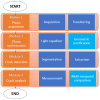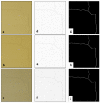Image-Based Monitoring of Cracks: Effectiveness Analysis of an Open-Source Machine Learning-Assisted Procedure
- PMID: 35200725
- PMCID: PMC8876482
- DOI: 10.3390/jimaging8020022
Image-Based Monitoring of Cracks: Effectiveness Analysis of an Open-Source Machine Learning-Assisted Procedure
Abstract
The proper inspection of a cracks pattern over time is a critical diagnosis step to provide a thorough knowledge of the health state of a structure. When monitoring cracks propagating on a planar surface, adopting a single-image-based approach is a more convenient (costly and logistically) solution compared to subjective operators-based solutions. Machine learning (ML)- based monitoring solutions offer the advantage of automation in crack detection; however, complex and time-consuming training must be carried out. This study presents a simple and automated ML-based crack monitoring approach implemented in open sources software that only requires a single image for training. The effectiveness of the approach is assessed conducting work in controlled and real case study sites. For both sites, the generated outputs are significant in terms of accuracy (~1 mm), repeatability (sub-mm) and precision (sub-pixel). The presented results highlight that the successful detection of cracks is achievable with only a straightforward ML-based training procedure conducted on only a single image of the multi-temporal sequence. Furthermore, the use of an innovative camera kit allowed exploiting automated acquisition and transmission fundamental for Internet of Things (IoTs) for structural health monitoring and to reduce user-based operations and increase safety.
Keywords: Ilastik; ImageJ; crack; image processing; machine learning; monitoring; segmentation.
Conflict of interest statement
The authors declare no conflict of interest.
Figures








Similar articles
-
Fast Detection of Missing Thin Propagating Cracks during Deep-Learning-Based Concrete Crack/Non-Crack Classification.Sensors (Basel). 2023 Jan 27;23(3):1419. doi: 10.3390/s23031419. Sensors (Basel). 2023. PMID: 36772459 Free PMC article.
-
Identification, 3D-Reconstruction, and Classification of Dangerous Road Cracks.Sensors (Basel). 2023 Mar 29;23(7):3578. doi: 10.3390/s23073578. Sensors (Basel). 2023. PMID: 37050640 Free PMC article.
-
An Ensemble Approach for Robust Automated Crack Detection and Segmentation in Concrete Structures.Sensors (Basel). 2024 Jan 1;24(1):257. doi: 10.3390/s24010257. Sensors (Basel). 2024. PMID: 38203119 Free PMC article.
-
A review of image analysis and machine learning techniques for automated cervical cancer screening from pap-smear images.Comput Methods Programs Biomed. 2018 Oct;164:15-22. doi: 10.1016/j.cmpb.2018.05.034. Epub 2018 Jun 26. Comput Methods Programs Biomed. 2018. PMID: 30195423 Review.
-
ilastik: interactive machine learning for (bio)image analysis.Nat Methods. 2019 Dec;16(12):1226-1232. doi: 10.1038/s41592-019-0582-9. Epub 2019 Sep 30. Nat Methods. 2019. PMID: 31570887 Review.
Cited by
-
Non-Destructive Testing Methods for In Situ Crack Measurements and Morphology Analysis with a Focus on a Novel Approach to the Use of the Acoustic Emission Method.Materials (Basel). 2023 Nov 29;16(23):7440. doi: 10.3390/ma16237440. Materials (Basel). 2023. PMID: 38068184 Free PMC article. Review.
-
Quantification of Structural Defects Using Pixel Level Spatial Information from Photogrammetry.Sensors (Basel). 2023 Jun 25;23(13):5878. doi: 10.3390/s23135878. Sensors (Basel). 2023. PMID: 37447731 Free PMC article.
References
-
- MIT Italian Ministry of Infrastructure and Transport. Aggiornamento delle «Norme tecniche per le costruzioni». Gazzetta Ufficiale. Feb 20, 2018. pp. 1–198. (In Italian)
-
- Shan B., Zheng S., Ou J. A stereovision-based crack width detection approach for concrete surface assessment. KSCE J. Civ. Eng. 2016;20:803–812. doi: 10.1007/s12205-015-0461-6. - DOI
-
- Feng H., Li W., Luo Z., Chen Y., Fatholahi S.N., Cheng M., Wang C., Junior J.M., Li J. GCN-Based Pavement Crack Detection using mobile LiDAR point clouds. IEEE Trans. Intell. Transp. Syst. 2021:1–10. doi: 10.1109/TITS.2021.3099023. - DOI
-
- Bellagamba I., Caponero M., Mongelli M. Using fiber-optic sensors and 3D photogrammetric reconstruction for crack pattern monitoring of masonry structures at the Aurelian Walls in Rome, Italy. WIT Trans. Built Environ. 2019;191:457–465. doi: 10.2495/STR190391. - DOI
LinkOut - more resources
Full Text Sources

